Annular Eclipse Over Bangkok
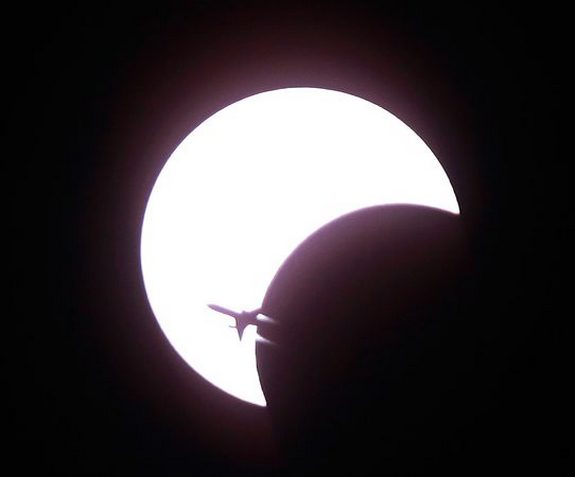
An airplane is silhouetted against the first solar eclipse of the decade, seen over Bangkok, Thailand, in January. The annular eclipse blotted out 57 to 80 percent of the sun over Thailand, depending on the province, Sakshin Bunthawin of Songkla University told the Phuket Gazette.
Hubble’s Mystic Mountain
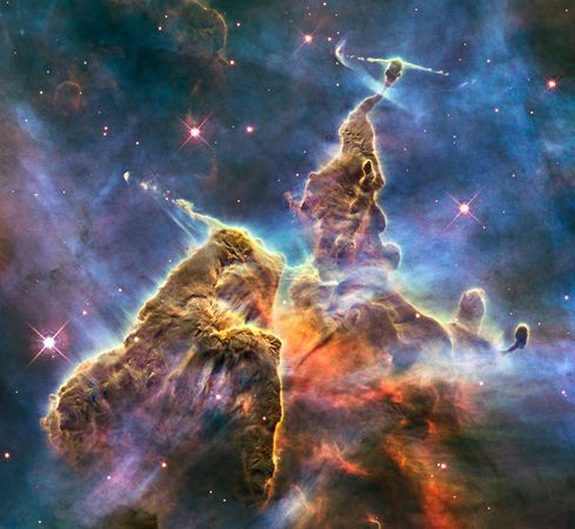
A colorful, craggy column of dust and gas dubbed the Mystic Mountain stars in a picture from theHubble Space Telescope released April 23 as part of celebrations for Hubble’s 20th anniversary. The picture highlights the results of star birth in the Carina nebula.
Mars and a Moonbow
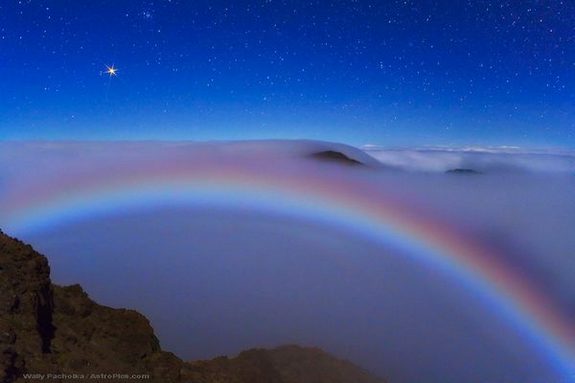
Mars shines like a bright red star over a “moonbow” in fog surrounding Hawaii’s Haleakala volcano in January. This photograph, originally published in “Space Photos This Week: Shuttle Launch, Moonbow,” was taken as Mars was about to make its closest pass by Earth for 2010.
Star Death in 3-D
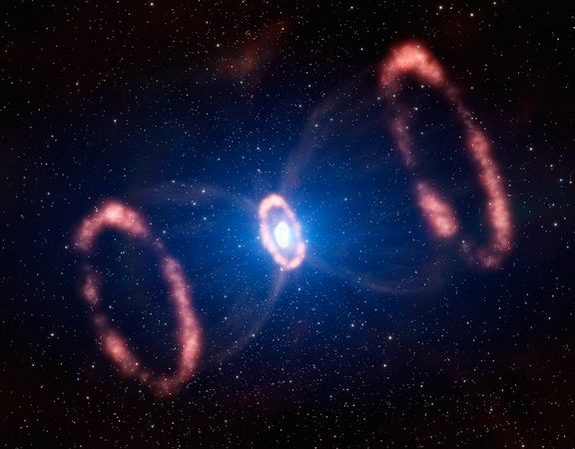
The hourglass shape of the supernova remnant SN 1987A isn’t as well balanced as thought, according to an August picture of the exploded star. Using data on the remnant from the European Southern Observatory’s Very Large Telescope in Chile, astronomers were able to confirm that, when massive stars explode, some of the ejected material gets shot into space faster than other debris, as predicted by computer models.
Big Bear’s Sunspot
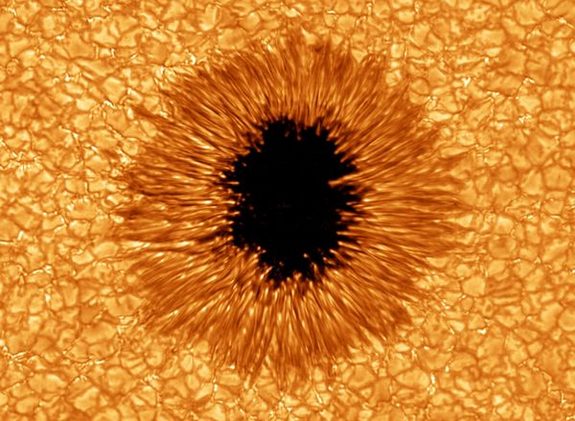
This crisp view of a sunspot, captured by New Jersey Institute of Technology’s New Solar Telescope and released in August, may be the most detailed picture of its kind yet shot in visible light, astronomers say. The 5.25-foot (1.6-meter) telescope, which became operational in 2009, sits at the school’s Big Bear Solar Observatory in the San Bernardino Mountains of California. The device uses a special deformable mirror—part of what’s called an adaptive optics system—to compensate for atmospheric distortions and produce ground-based images with about the same clarity as shots from orbiting observatories, experts say.
Saturn Moon’s Jets

Seen by NASA’s Cassini spacecraft, jets of water ice spewing from Saturn’s moon Enceladus seem to graze the bright edge of the planet in a shot released Tuesday. In reality, Enceladus orbits about 112,000 miles (180,000 kilometers) away from the top of Saturn’s atmosphere.
Discovered in 2005, the moon’s icy geysers shoot from fractures in the southern hemisphere and are thought to be driven by a subsurface layer of liquid water.
Hayabusa’s Fiery Return
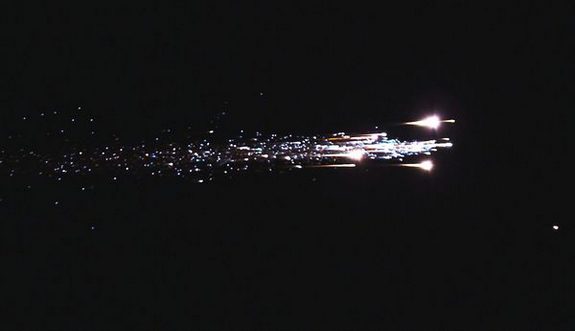
Like a sparkling firework, much of the Japanese space probe Hayabusa disintegrates as it reenters Earth’s atmosphere on June 13. Hidden in the shower of sparks was a heat-shielded, 16-inch (40-centimeter) capsule later found to contain precious scrapings from an asteroid, which could help us understand how our planet and solar system formed.
Hayabusa is among the few spacecraft to return rock samples from space. Other such missions include the Apollo program, which retrieved moon rocks in the late 1960s and early ’70s, and the comet-dust harvester Stardust, which crashed into the Utah desert at 28,900 miles (46,400 kilometers) an hour in 2006.
“Ephemeral” Lake

Patches of southern Australia’s shallow Lake Eyre seem to form a grimacing face in an August 2006 satellite picture. The picture is 1 of 40 released as part of November 2010’s Earth as Art 3 collection, the latest compilation of NASA and U.S. Geological Survey Landsat pictures chosen for their artistic quality.
Close Encounter With Lutetia
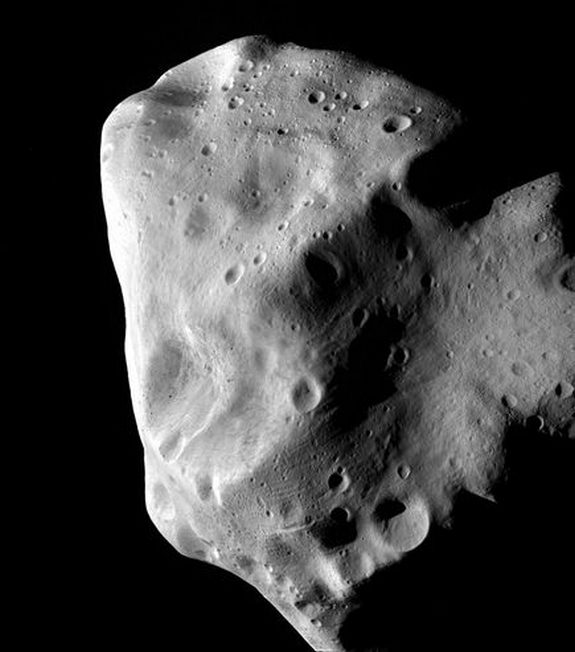
Asteroid 21 Lutetia is exposed, craters and all, in a picture captured in July by the European Space Agency’s Rosetta spacecraft. Rosetta’s close encounter with Lutetia revealed a battered world—a possible remnant from the birth of our solar system, astronomers say.
To snap the above image, Rosetta swooped about 1,965 miles (3,162 kilometers) above Lutetia’s surface. The image is the highest-resolution photo taken of the space rock, located more than 270 million miles (440 million kilometers) away from Earth, between the orbits of Mars and Jupiter.
Aurora Australis From Space

Even for astronauts, this May image was a rare sight indeed: an aurora hovering over the southernIndian Ocean.
Auroras occur when charged particles from the sun collide with Earth’s upper atmosphere, causing atoms of oxygen and nitrogen to gain energy and then release it in the form of light.
Gulf Oil Spill’s Spread
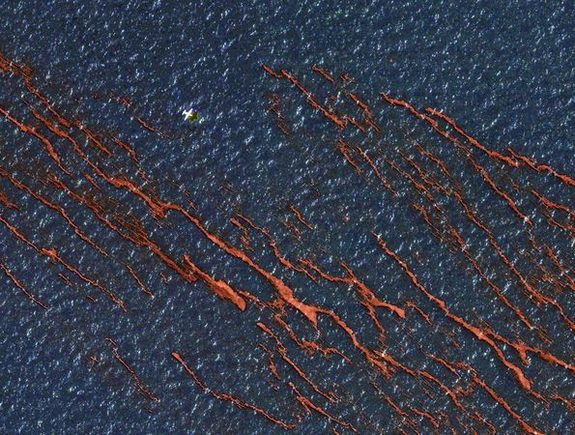
A satellite picture taken in April captures a small plane flying over rust-colored “streamers” of crude oil visible on the surface of the Gulf, about a week after the Deepwater Horizon oil rig sank into the Gulf of Mexico.
The extent of the spread made it more difficult for authorities to execute one of their planned strategies for containing the spill—controlled burns of the oil.
Starbirth Near the Void

Reddish puffs mark the spots where stars were recently born in a new Hubble Space Telescope picture of the dwarf spiral galaxy NGC 6503 released Monday.The galaxy, a smaller version of our own Milky Way, sits 17 million light-years from Earth at the edge of a sparsely populated region of space calledthe Local Void.

An airplane is silhouetted against the first solar eclipse of the decade, seen over Bangkok, Thailand, in January. The annular eclipse blotted out 57 to 80 percent of the sun over Thailand, depending on the province, Sakshin Bunthawin of Songkla University told the Phuket Gazette.
Hubble’s Mystic Mountain

A colorful, craggy column of dust and gas dubbed the Mystic Mountain stars in a picture from theHubble Space Telescope released April 23 as part of celebrations for Hubble’s 20th anniversary. The picture highlights the results of star birth in the Carina nebula.
Mars and a Moonbow

Mars shines like a bright red star over a “moonbow” in fog surrounding Hawaii’s Haleakala volcano in January. This photograph, originally published in “Space Photos This Week: Shuttle Launch, Moonbow,” was taken as Mars was about to make its closest pass by Earth for 2010.
Star Death in 3-D

The hourglass shape of the supernova remnant SN 1987A isn’t as well balanced as thought, according to an August picture of the exploded star. Using data on the remnant from the European Southern Observatory’s Very Large Telescope in Chile, astronomers were able to confirm that, when massive stars explode, some of the ejected material gets shot into space faster than other debris, as predicted by computer models.
Big Bear’s Sunspot

This crisp view of a sunspot, captured by New Jersey Institute of Technology’s New Solar Telescope and released in August, may be the most detailed picture of its kind yet shot in visible light, astronomers say. The 5.25-foot (1.6-meter) telescope, which became operational in 2009, sits at the school’s Big Bear Solar Observatory in the San Bernardino Mountains of California. The device uses a special deformable mirror—part of what’s called an adaptive optics system—to compensate for atmospheric distortions and produce ground-based images with about the same clarity as shots from orbiting observatories, experts say.
Saturn Moon’s Jets

Seen by NASA’s Cassini spacecraft, jets of water ice spewing from Saturn’s moon Enceladus seem to graze the bright edge of the planet in a shot released Tuesday. In reality, Enceladus orbits about 112,000 miles (180,000 kilometers) away from the top of Saturn’s atmosphere.
Discovered in 2005, the moon’s icy geysers shoot from fractures in the southern hemisphere and are thought to be driven by a subsurface layer of liquid water.
Hayabusa’s Fiery Return

Like a sparkling firework, much of the Japanese space probe Hayabusa disintegrates as it reenters Earth’s atmosphere on June 13. Hidden in the shower of sparks was a heat-shielded, 16-inch (40-centimeter) capsule later found to contain precious scrapings from an asteroid, which could help us understand how our planet and solar system formed.
Hayabusa is among the few spacecraft to return rock samples from space. Other such missions include the Apollo program, which retrieved moon rocks in the late 1960s and early ’70s, and the comet-dust harvester Stardust, which crashed into the Utah desert at 28,900 miles (46,400 kilometers) an hour in 2006.
“Ephemeral” Lake

Patches of southern Australia’s shallow Lake Eyre seem to form a grimacing face in an August 2006 satellite picture. The picture is 1 of 40 released as part of November 2010’s Earth as Art 3 collection, the latest compilation of NASA and U.S. Geological Survey Landsat pictures chosen for their artistic quality.
Close Encounter With Lutetia

Asteroid 21 Lutetia is exposed, craters and all, in a picture captured in July by the European Space Agency’s Rosetta spacecraft. Rosetta’s close encounter with Lutetia revealed a battered world—a possible remnant from the birth of our solar system, astronomers say.
To snap the above image, Rosetta swooped about 1,965 miles (3,162 kilometers) above Lutetia’s surface. The image is the highest-resolution photo taken of the space rock, located more than 270 million miles (440 million kilometers) away from Earth, between the orbits of Mars and Jupiter.
Aurora Australis From Space

Even for astronauts, this May image was a rare sight indeed: an aurora hovering over the southernIndian Ocean.
Auroras occur when charged particles from the sun collide with Earth’s upper atmosphere, causing atoms of oxygen and nitrogen to gain energy and then release it in the form of light.
Gulf Oil Spill’s Spread

A satellite picture taken in April captures a small plane flying over rust-colored “streamers” of crude oil visible on the surface of the Gulf, about a week after the Deepwater Horizon oil rig sank into the Gulf of Mexico.
The extent of the spread made it more difficult for authorities to execute one of their planned strategies for containing the spill—controlled burns of the oil.
Starbirth Near the Void

Reddish puffs mark the spots where stars were recently born in a new Hubble Space Telescope picture of the dwarf spiral galaxy NGC 6503 released Monday.The galaxy, a smaller version of our own Milky Way, sits 17 million light-years from Earth at the edge of a sparsely populated region of space calledthe Local Void.
